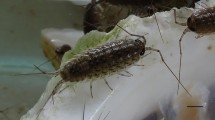Summary
The green iguana, Iguana iguana, is herbivorous throughout life, and depends on a microbial fermentation system in the hindgut to degrade plant fiber. Because the metabolic rates of lizards are proportional to body mass raised to the 0.80 power, hatchling iguanas have 2X, and juveniles 1.4X, greater relative energy requirements (kJxg body mass-1xday-1) than full-grown adults. Growing animals also need a higher protein intake, for contruction of body tissues, than do mature animals. This study investigated how growing iguanas achieve a relatively greater nutrient intake than adults. Hatchling and juvenile iguanas do not have higher relative capacities of the digestive tract than mature iguanas, nor do they digest plant materials more effectively. Instead, growing iguanas select diets higher in digestible protein, and digest the same food 1.3X to 2X more rapidly, than adults. Young iguanas may accomplish their shorter food transit times by maintaining higher body temperatures.
Similar content being viewed by others
References
Bennett AF, Dawson WR (1976) Metabolism. In: Gans C, Dawson WR (eds) Biology of the Reptilia, Volume 5 (Physiology A). Academic Press, New York, pp 127–223
Bjorndal K (1979) Cellulose digestion and volatile fatty acid production in the green turtle, Chelonia mydas. Comp Biochem Physiol 63A:127–133
Demment MW, Van Soest PJ (1982) Body size, digestive capacity and feeding strategies of herbivores. Winrock Research Publications, Morrilton, Arkansas
Harlow HJ, Hillman SS, Hoffman N (1976) The effect of temperature on digestive efficiency in the lizard, Dipsosaurus dorsalis. J Comp Physiol 111:1–6
Henderson RW (1974) Aspects of the ecology of the juvenile common iguana (Iguana iguana). Herpetologica 30:327–332
Hirth HF (1963) Some aspects of the natural history of Iguana iguana on a tropical strand. Ecology 44:613–615
Hungate RE (1966) The Rumen and Its Microbes. Academic Press, New York
Hungate RE, Phillips CO, MacGregor A, Hungate DP, Buechner HK (1959) Microbial fermentation in certain mammals. Science 130:1192–1194
Iverson JB (1980) Colic modifications in iguanine lizards. J Morphol 163:79–93
Janis C (1976) The evolutionary strategy of the Equidae, and the origins of rumen and cecal digestion. Evolution 30:757–774
Jarman PG (1974) The social organisation of antelope in relation to their ecology. Behaviour 48:215–267
McBee RH (1971) Significance of the intestinal microflora in herbivory. Annu Rev Ecol Syst 1:65–176
McBee RH, McBee VH (1982) Volatile fatty acid production in the green iguana, Iguana iguana. In: Burghardt GM, Rand AS (eds) Iguanas of the World: Their Behavior, Ecology, and Conservation. Noyes Publications, Park Ridge, New Jersey, pp 77–83
McGinnis SM, Brown CM (1966) Thermal behavior of the green iguana, Iguana iguana. Herpetologica 22:189–199
Müller H (1972) Ökologische und ethologische Studien an Iguana iguana in Kolombien. Zool Beitr 18:109–131
Nagy KA (1977) Cellulose digestion and nutrient assimilation in Sauromalus obesus, a plant-eating lizard. Copeia 1977:355–362
Nagy KA (1982) Energy requirements of free-living iguanid lizards. In: Burghardt GM, Rand AS (eds) Iguanas of the World: Their Behavior, Ecology, and Conservation. Noyes Publications, Park Ridge, New Jersey, pp 49–59
Ostrum JH (1963) Further comments on herbivorous lizards. Evolution 17:368–369
Parra R (1978) Comparison of foregut and hindgut fermentation in herbivores. In: Montgomery GG (ed) The Ecology of Arboreal Folivores. Smithsonian Institution Press, Washington, D.C., pp 205–229
Pough FH (1973) Lizard energetics and diet. Ecology 54:837–844
Robertson JB, Van Soest PJ (1981) The detergent system of analysis and its application to human foods. In: James WPT, Theander O (eds) The Analysis of Dietary Fiber in Food. Marcel Dekker Inc., New York, pp 123–158
Sokol OM (1967) Herbivory in lizards. Evolution 21:192–194
Szarski H (1962) Some remarks on herbivorous lizards. Evolution 16:529
Troyer K (1982) Transfer of fermentative microbes between generations in a herbivorous lizard. Science 216:540–542
Troyer K (1984) Structure and function of the digestive tract of a herbivorous lizard. Physiol Zool (in press)
Troyer K Behavioral acquisition of the hindgut fermentation system by a herbivorous lizard, Iguana iguana. Behav Ecol Sociobiol (in press)
Van Soest PJ (1982) Nutritional Ecology of the Ruminant. O&B Books Inc., Corvallis, Oregon
White TCR (1978) The importance of a relative shortage of food in animal ecology. Oecologia (Berlin) 33:71–86
Wilhoft DC (1958) Observations on preferred body temperature and feeding habits of some selected tropical iguanas. Herpetologica 14:161–164
Author information
Authors and Affiliations
Rights and permissions
About this article
Cite this article
Troyer, K. Diet selection and digestion in Iguana iguana: the importance of age and nutrient requirements. Oecologia 61, 201–207 (1984). https://doi.org/10.1007/BF00396761
Received:
Issue Date:
DOI: https://doi.org/10.1007/BF00396761




